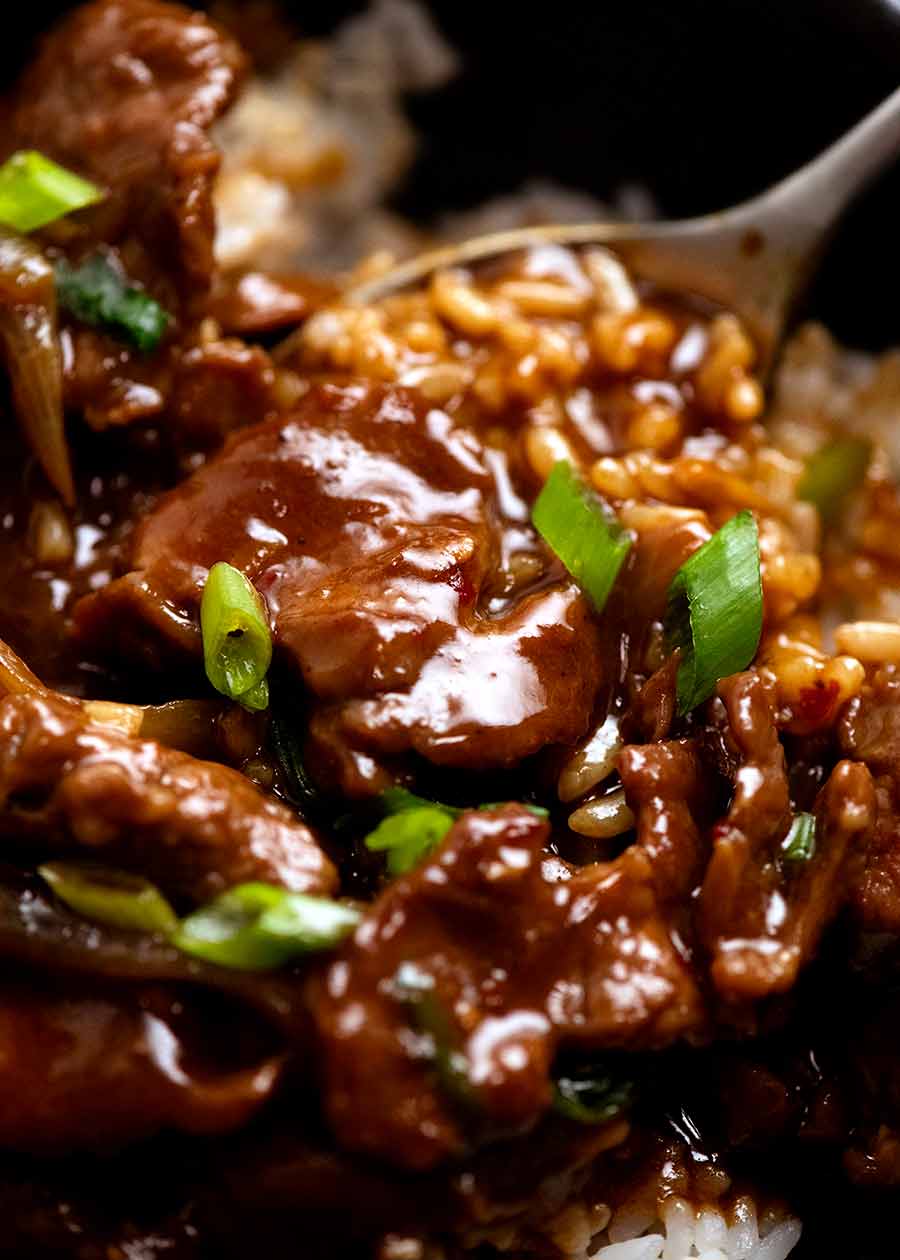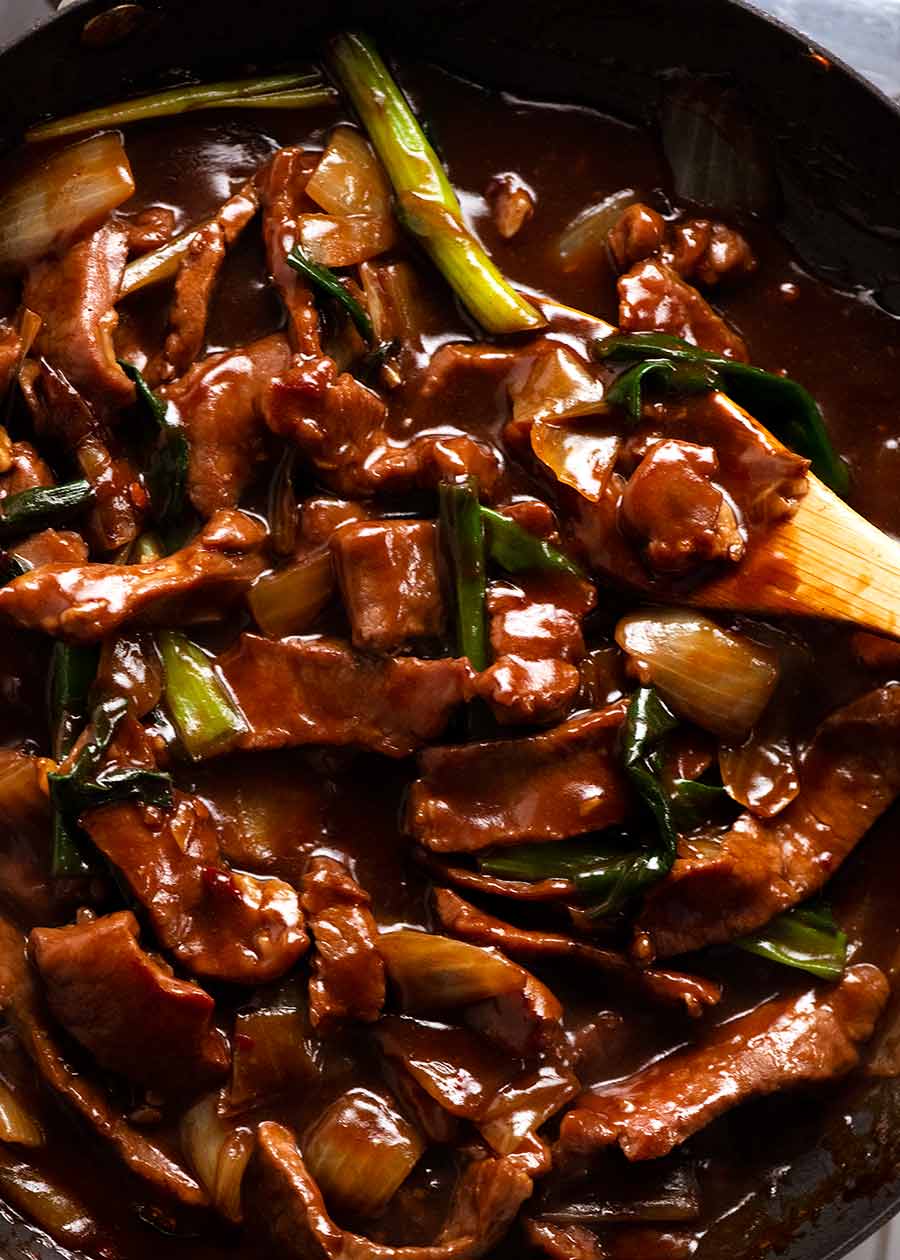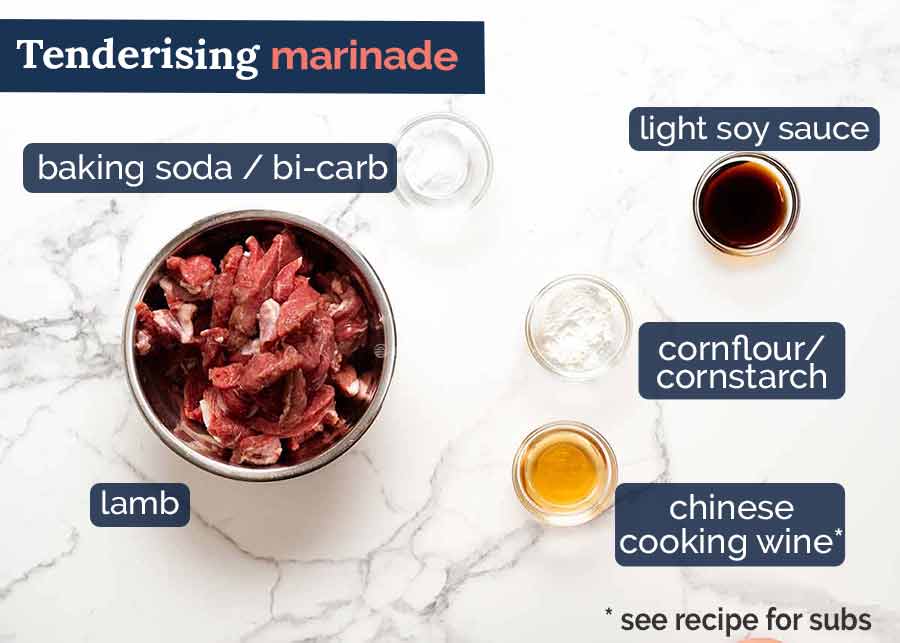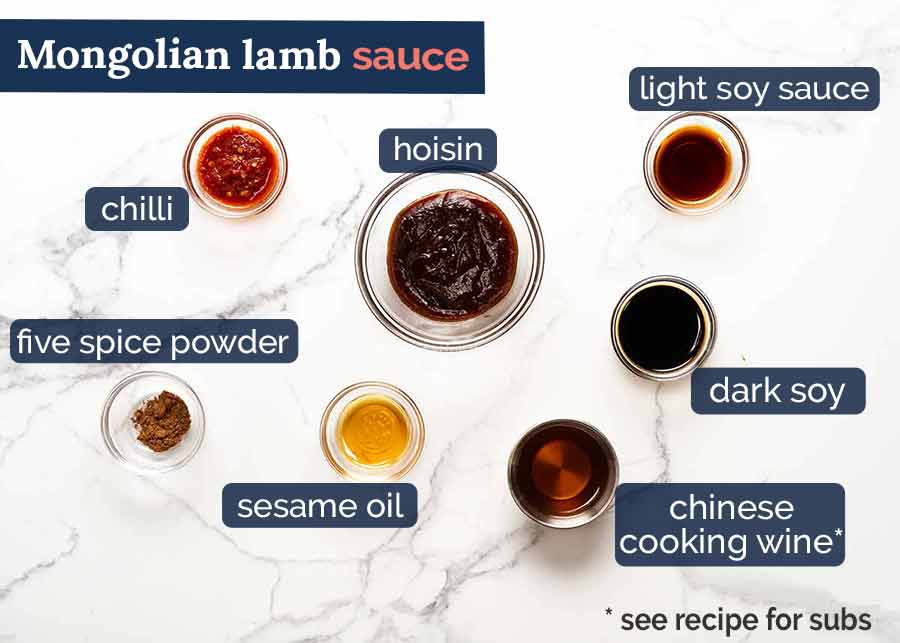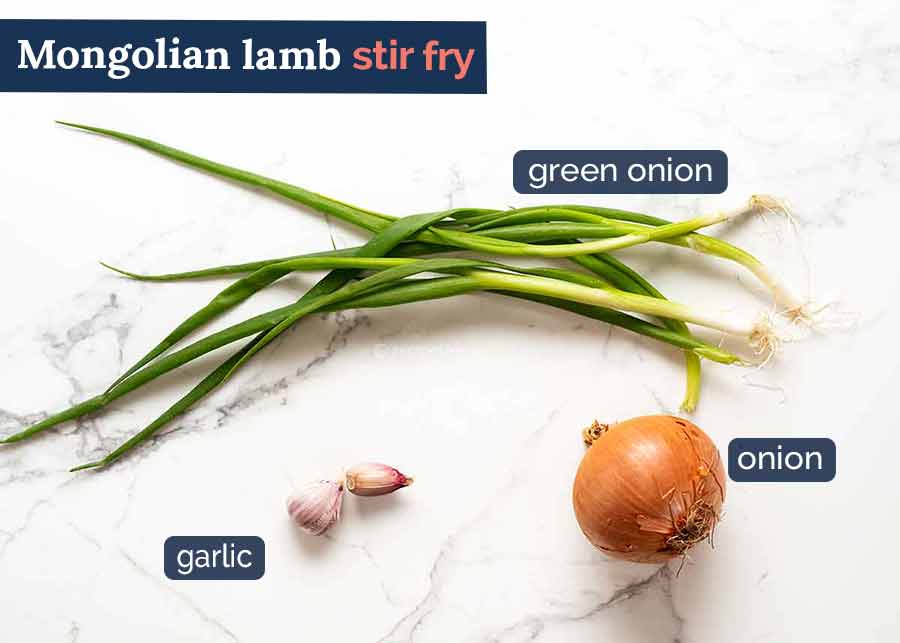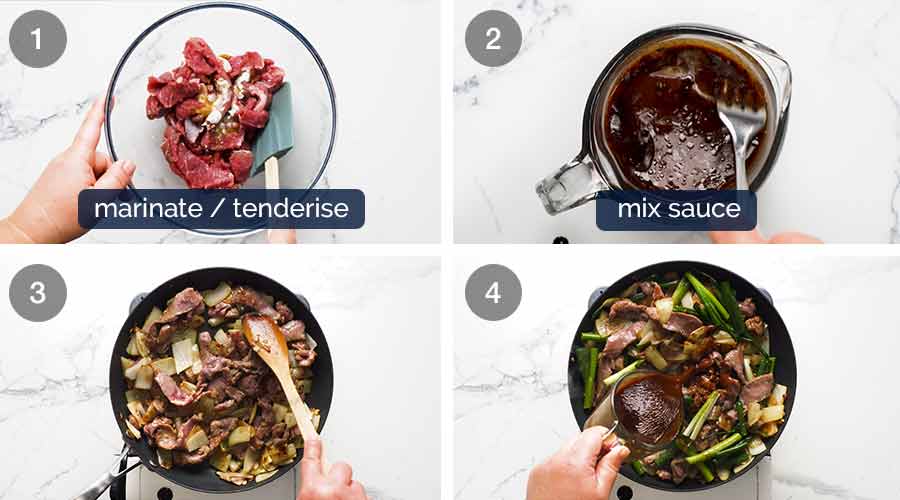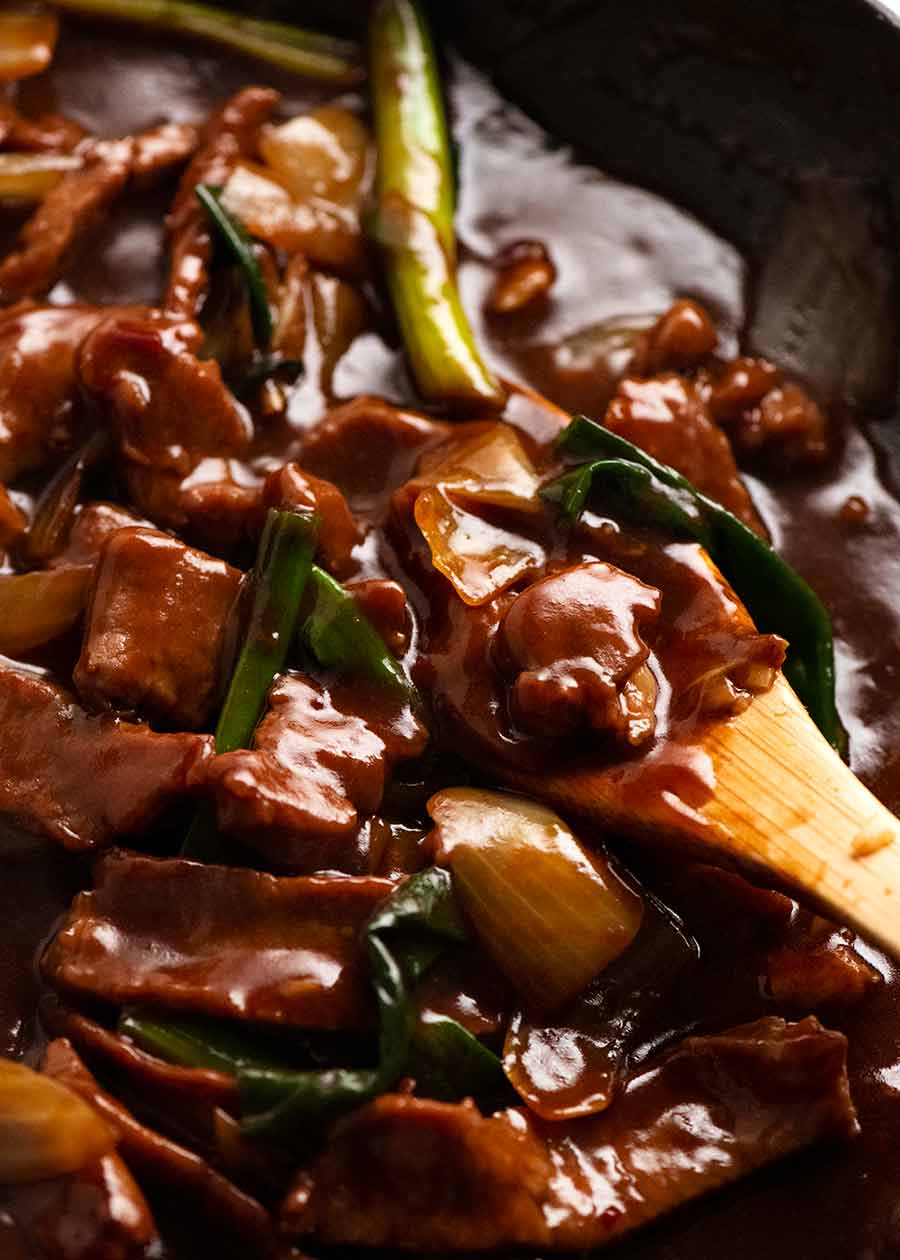Sizzle aside, this homemade version is a near perfect replica. Even the velveted texture of the lamb!
Mongolian Lamb
Mongolian Lamb is a Chinese stir fry that’s made with tenderised, marinated strips of lamb in a dark sweet-savoury sauce perfumed with Chinese Five Spice. It’s not an authentic Chinese dish, and almost certainly has nothing to do with Mongolia. The truth is nobody really knows why it’s called Mongolian Lamb. But it’s a Chinese-Australian takeaway classic nonetheless that every Aussie knows and loves! Nope! Different sauce – while the American Mongolian Beef is also sweet, it doesn’t have the hoisin five spice flavour. Also Mongolian Beef is typically crispy fried strips of beef. Both are equally delicious in different ways!
Restaurant copycat
Every restaurant does their Mongolian Lamb differently and there isn’t, to my knowledge, a standard recipe. This is the RecipeTin Family version, a copycat of the Mongolian Lamb we had as kids, when going out to the local Chinese restaurant for dinner was a rare and special treat! Mongolian Lamb lovers – this will knock your socks off. I dare to say it’s a perfect replica (well, minus the cast iron pan sizzling!)
What goes in Mongolian Lamb Marinade
Here’s what you need for the Mongolian Lamb marinade which tenderises the lamb – Chinese restaurant style!
Baking soda (bi-carb) and cornflour / cornstarch are used to tenderise the lamb as Chinese restaurants do so it’s soft and tender, whether using a pricy cut like backstrap OR economical slow cooking cut like shoulder. More on this below; Lamb – the best cut is backstrap followed by mid loin chops then shoulder. However, ANY cut of lamb can be used because the meat is tenderised – you just need to tenderise tougher cuts for longer than tender cuts. See list below. Soy sauce and Chinese Cooking Wine(Shaoxing wine) – these add flavour and salt into the lamb. See recipe notes for substitute for Chinese Cooking Wine.
Best lamb for Mongolian Lamb
The best cut is backstrap followed by mid loin chops then shoulder.
Backstrap – a very tender cut that’s quite lean, typically the cut of choice for posher Chinese restaurants; Mid loin chops – better value than backstrap but cut from the same part of lamb so similar tenderness; and Shoulder – excellent economical option with great lamb flavour. Suburban Chinese restaurants seem to typically opt for for this cut.
Other lamb cuts and marinating time
Having said that, Mongolian Lamb is excellent made with ANY cut of lamb because the marinade tenderises the meat (see below for more on tenderising). Economical cuts need to be tenderised for longer (24 hours) but once cooked, they are almost as tender as expensive cuts like lamb backstrap! Here is a list of common lamb cuts and how long they need to be marinated for – note that Mongolian Lamb is excellent made with any of these, it comes down to price, marinating time and convenience of cutting:
Tender Cuts – 2 hour marinade
backstrap / fillet / loin (different name for same cut) – my first choice when discounted! mid loin chops – my most used, you need ~700g/1.4lb (you lose alot in fat and bone) chump chop and lamb rump (roast or steak. FYI, this is chump chop minus bone!) – excellent leaner option that’s less expensive than backstrap. (Lean doesn’t mean dry in this recipe because of the tenderising marinade) cutlets (I never use, too expensive!)
Economical Cuts – 24 hour marinade
lamb shoulder – my 3rd most used, excellent ribbons of fat but need trim around sinewy bits which won’t tenderise; leg (steak or roast) – leaner alternative to shoulder with less sinewy bits to cut around, lamb flavour not as strong; and forequarter chops and neck – bit fatty but really great lamb flavour.
TIPS choosing a cut:
Economical cuts tend to have better lamb flavour than Tender Cuts but you do need to cut around rivers of sinewy bits which won’t tenderise even with the magic marinade; “Posher” Chinese restaurants typically use Backstrap; Your everyday suburban restaurant typically uses economical cuts – lamb shoulder seems common; Lamb Rump / chump chops is my pick for easy to cut but cheaper than backstrap.
Because the lamb is sliced thinly so it’s impossible to cook until “perfectly pink inside” like you do with any lamb chops or steaks so it tends to go tough. Tenderising makes lamb impossible to overcook as well as that velvety, ultra moist texture of meat in dishes served at Chinese restaurants.
Tenderising lamb meat
Baking soda / bi-carb and cornflour/cornstarch are the secret ingredients that tenderise the lamb meat. It’s a technique called “velveting” that is used by Chinese restaurants, and it’s the reason why the meat in your favourite Chinese dishes are always so soft.
2 hour marinade/tenderise – Rump, flank, sirloin/strip/Porterhouse (same thing), t-bone and scotch fillet/boneless rib eye. 24 hours – Chuck beef, gravy beef, oyster beef and other traditional stewing beef, blade, bolar blade. Only cut I do NOT recommend is brisket (doesn’t seem to tenderise well)
There’s various methods used. The two that I employ are:
Tenderising Marinade using a small amount of baking soda/cornflour combination (like in this Mongolian Lamb and Sweet and Sour Pork) along with flavours, left to marinade for 1 hour+ or overnight; and “Hard and Fast” Tenderising Method which calls for more baking soda, a shorter marinating time (20 – 30 minutes) and rinsing. This is my base method for chicken and beef slices for stir fries.
Mongolian Lamb Sauce ingredients
And here’s what you need for the Mongolian Lamb Sauce:
All the key ingredients here feature in Tier 1 of my Asian Market Shopping List!
Chinese Five Spice Powder – a spice blend of five spices (shock horror! 😂), very common nowadays, sold at grocery stores and no more expensive than other spices. Also used in Chinese Beef and Broccoli, Chicken and Broccoli, Sticky Chinese Wings, Crispy Chinese Pork Belly. Search “five spice powder” for more recipes (pro tip: click “Ingredients” to see all recipes that use it); Hoisin is a key flavouring ingredient for Mongolian Lamb Sauce. Sweet with savoury undertones, perfumed with Five Spice Powder, you’ll find it in the Asian aisle at any supermarket nowadays. Lee Kum Kee, Changs or Tung Chun are all good brands – AVOID Ayam. Wrong colour and flavour; Chinese cooking wine – essential for authentic Chinese restaurant sauces, and this recipe is no exception! Substitute with: dry sherry, Mirin or low sodium chicken stock/broth. Chilli paste – I like using Sambal Oelak or Chilli Garlic Sauce because both these have extra flavouring in them. But anything spicy will do – even Sriracha. This is not an overly spicy dish but Mongolian Lamb does have a bit of chilli in it; Dark soy sauce is what makes the sauce a deep mahogany colour and adds flavour, whereas light soy or all purpose soy sauce adds salt without colouring the sauce more. Read more about soy sauces – Soy Sauce; different types, when to use what, best substitutes; and Sesame oil, toasted – toasted sesame oil is brown and has more flavour than untoasted (which is yellow). Default sesame oil sold in Australia is toasted, untoasted is harder to find.
What goes in the Mongolian Lamb stir fry
Just 3 simple things required for the stir fry!
How to make Mongolian Lamb
Nice and simple: marinate the lamb, mix the sauce, then it all gets cooked in one wok or skillet in a matter of minutes!
Once the sauce goes in, simmer for a minute or two until the sauce thickens beautifully, dark and glossy.
How to serve Mongolian Lamb
Rice is essential because it would be criminal not to be able to scoop up huge spoonfuls of rice soaked in that wickedly good Mongolian Lamb sauce. If you’re attempting the low carb thing (and believe me, I force myself onto that bandwagon every now and then), cauliflower rice is an excellent alternative though if you have the time, try Cauliflower Fried Rice instead (this makes low-carb infinitely more enjoyable). For your vegetable quota, you could add around 2 cups of vegetables like carrots and zucchini chopped into batons into this stir fry. Cook them with the onion before adding the lamb as they will take longer to cook. Don’t use broccoli or broccolini because they heads will soak up too much of the sauce. Sauce hogs! Otherwise, just chop up fresh veggies or steam a pile of any vegetables and toss with Sesame Dressing or try this brilliant salad, Chinese Lettuce with Creamy Sesame Sauce. Excellent quick vegetable side option for all things Asian that I use regularly! – Nagi x
Watch how to make it
Stir-fry favourites
Life of Dozer
When he somehow got in but couldn’t figure out how to get out. He cried like a girl until I saved him. 🙄
